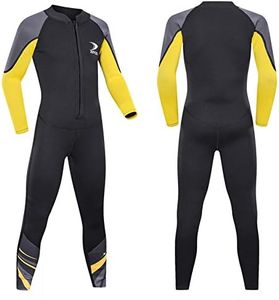We Use CookiesWe use cookies to enhance the security, performance,
functionality and for analytical and promotional activities. By continuing to browse this site you
are agreeing to our privacy policy
10 Best Kids Wetsuits
From leading brands and best sellers available on the web.Buying Guide for the Best Kids Wetsuits
When it comes to selecting a wetsuit for kids, the main goal is to keep your child comfortable, warm, and protected while they are playing or learning in the water. It isn’t just about picking the most expensive or best-looking suit; rather, you should focus on features that suit the child’s needs, the water temperature, and how long they’ll spend in or near the water. The right wetsuit should be easy to put on, fit snugly without restricting movement, and offer enough insulation for the intended conditions. Understanding some key features can help you choose a wetsuit that your child will actually enjoy wearing and that you can trust to perform.Material ThicknessMaterial thickness, often measured in millimeters, tells you how insulating the wetsuit will be. Thicker suits (like 4mm or 5mm) are warmer and meant for colder water, while thinner suits (2mm or 3mm) are better for warmer conditions. A suit might also list two numbers (like 3/2mm), which means it's thicker in the body and thinner in the arms and legs. For occasional use at the beach in the summer, a thinner wetsuit is fine, while kids spending more time in cooler water or surfing might need something thicker. Consider the water temperature where your child will use it, and pick a thickness that matches how chilly it gets.
Fit and SizingFit is crucial for a wetsuit’s performance. The suit should be snug all over, but not so tight that it’s uncomfortable or restricts movement, especially around the neck, wrists, and ankles. A loose suit lets water in, which can defeat the purpose of wearing one. Sizing varies between brands, so always refer to the manufacturer’s measurement guide. Think about your child’s growth: pick a suit that fits well now rather than one they could 'grow into,' since too-big suits won’t keep them as warm or protected.
Sleeve and Leg LengthWetsuits come in different lengths, such as full suits (covering arms and legs) and shorties (short sleeves and legs). Full suits provide more warmth and sun protection, ideal for cooler water or windier conditions. Shorties are easier to put on and cooler, making them good for warm-weather swimming. Choose based on the typical water temperature and how much sun or wind exposure your child will face.
Seam ConstructionHow the wetsuit is stitched matters for warmth and durability. Flatlock seams are comfortable and breathable, typically found in suits for warmer conditions since they let in a little water. Glued and blind-stitched seams are better for colder water, as they keep more water out and provide more insulation. If your child will mostly play in warm, shallow water, simpler seams are fine. For longer stays in chilly water, look for advanced seam construction.
Ease of Entry (Zipper Type)Wetsuits usually have back zippers, chest zippers, or are designed to be stepped into. Back zippers are easiest for kids to get on and off, making them a common choice. Chest zippers can offer better flexibility and insulation, but might be trickier for kids. Think about how independent your child is when dressing and undressing—a suit that's easy for them to put on and take off will be most practical.
Sun and Rash ProtectionBesides warmth, many wetsuits protect against the sun's harmful rays (look for information about UV protection) and help reduce chafing from sand or salt water. This is especially important for kids with sensitive skin or if they'll be outside for extended periods. Choosing a suit with good coverage can minimize sunburn and irritation, leaving you with fewer things to worry about during fun outings.
















